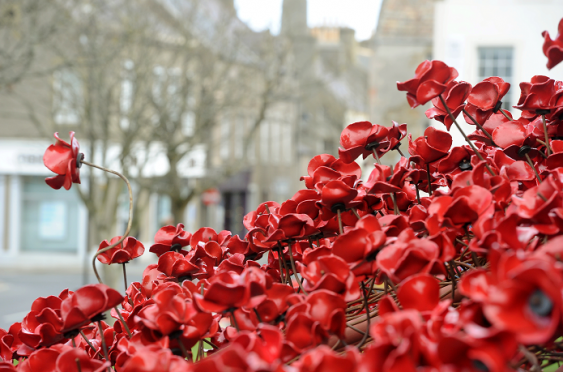It was a poignant crimson tide that brought a prime minister, a president and royalty in its wake to Orkney.
But now the sea of ceramic poppies, first seen at the Tower of London, that went on display in Orkney as part of First World War commemorations has been revealed as also boosting the islands’ economy by £2m.
The Weeping Window sculpture was installed last year at St Magnus Cathedral in Kirkwall where the public viewed the work between April 22 and June 12. The then Prime Minister David Cameron and German President Joachim Gauck, along with the Princess Royal and her husband Vice Admiral Sir Tim Laurence, were among those who visited Orkney to mark the 100th anniversary of the biggest naval battle in the First World War – the Battle of Jutland.
Now a report says around 9,000 people visited Kirkwall last year specifically to see the Weeping Window display at St Magnus Cathedral.
During the time the sculpture was in Orkney, there were a total of 43,446 visits – including locals – to the cathedral at an average of 7,241 a week. The final nine days alone attracted 14,404 visits. The report presented to Orkney Islands Council estimates that the poppies generated around £2m additional spend for the Orkney economy. A selection of visitors to the poppies were asked to complete a survey on their experience – a third of those questioned said that they were very likely to explore further the history of the poppy as a symbol of remembrance, while around a fifth were very interested in learning about the loss of life and about the war in general. The report shows that 39% of those who visited had a much better understanding of the loss of life, higher than those surveyed in Lincoln (26%) and in Perth (27%) where the display was also shown. The installation also helped visitors to understand more about Orkney’s role in the war effort.
The report also concludes that visitors were motivated by both the historical and artistic elements of the work. Nearly a third visited to commemorate and learn more about the First World War, whilst over half of those who visited did so because they considered it a major exhibition happening in the county.
Antony Mottershead, the council’s arts officer, said: “Almost a year on from the poppies arriving in Orkney this report reminds us of that very important period when we came together to remember and the huge impact the poppies had on people, both within our own community and visitors to the county. The additional spend generated by the poppies is also very substantial, the report clearly demonstrates just how powerful cultural experiences can be as an economic driver.”
The installation was originally at HM Tower of London in 2014 where 888,246 poppies were displayed, one to honour every death in the British and Colonial forces of the First World War.
